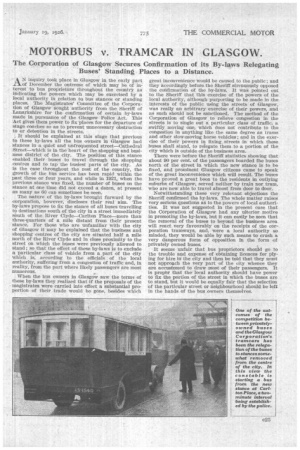MOTORBUS v. TRAMCAR IN GLASGOW.
Page 9

If you've noticed an error in this article please click here to report it so we can fix it.
The Corporation of Glasgow Secures Confirmation of its By-laws Relegating Buses' Standing Places to a Distance.
AN inquiry took place in Glasgow in the early part of December the outcome of which may be of interest to bus proprietors throughout the country as indicating the powers which may be exercised by a local authority in relation to bus stances or standing places. The Magistrates' Committee of the Corporation of Glasgow sought 'authority from the Sheriff of Lanarkshire for the confirmation of certain by-laws made in pursuance of the Glasgow Police Act. This Act gives them power to fix places for the departure of stage coaches so as to prevent unnecessary obstruction to or detention in the streets.
. It should be explained at this stage that previous to these by-laws all the bus owners in Glasgow had stances in a quiet and unfrequented street—Cathedral Street—which is in the heart of the shopping and business district of the city. The position of this stance enabled their buses to travel through the shopping centres and to tap the busiest parts of the city. As is the case throughout the rest of the country, the growth of the bus service has been rapid within the past three or four years, and while in 1921, when the previous stance was fixed, the number of buses on the stance at one time did not exceed a dozen, at present as many as 60 can sometimes be seen.
The nature of the by-laws brought forward by the corporation, however, discloses their real aim. The by-laws propose to fix the stance of all buses travelling to destinations south of the city in a street immediately south of the River Clyde—Carlton Place—more than three-quarters of a mile distant from their present stance. For those who are unfamiliar with the city of Glasgow it may be explained that the business and shopping centres of the city are situated half a mile north of the River Clyde and in close proximity to the street on which the buses were previously allowed to stand ; so that the effect of these by-laws is to exclude a particular class of vehicle from a part of the city which is, according to the officials of the local authority, suffering from a congestion of traffic and, in reality, from the part where likely passengers are most numerous.
When the bus owners in Glasgow saw the terms of these by-laws they realized that if the proposals of the magistrates were carried into effect a substantial proportion of their trade would be gone, besides which great inconvenience would be caused to the public ; and they accordingly before the Sheriff strenuously opposed the confirmation of the by-laws: It was pointed out to the Sheriff that this exercise of the powers of the local authority, although purporting to be made in the interests of the public using the streets of Glasgow, was really an arbitrary exercise of their powers, and as such should not be sanctioned. The method of the Corporation of Glasgow to relieve congestion in the streets is to single out a particular class of traffic, a swiftly moving one, which does not contribute to the congestion in anything like the same degree as trams and other slow-moving horse vehicles; and in the exercise of their powers in fixing streets in which these buses shall stand, to relegate them to a portion of the city which is outside of the business area.
There were before the Sheriff statistics showing that about 90 per cent, of the passengers boarded the buses north of the street in which the new stance is to be fixed, and prominent Glasgow citizens came to speak of the great inconvenience which will result. The buses have prJvecl a great boon to the residents in outlying suburbs of Glasgow, served neither by train nor tram, who are now able to travel almost from door to door.
Notwithstanding these very relevant objections the Sheriff confirmed the by-laws. The whole matter raises very serious questions as to the powers of local authorities. It was not suggested in the present case that the Corporation of Glasgow had any ulterior motive in promoting the by-laws, but it can easily be seen that the removal of the buses to beyond the business area will react very favourably on the receipts of the corporation tramways, and, were a local authority so minded, they would be able by such means to crush a very dangerous form of opposition In the form of privately owned buses.
It seems unfair that bus proprietors should go to the trouble and expense of obtaining licences for plying for hire in the city and then be told that they must not approach the very part of the city whence they are accustomed to draw most of their passengers. It is proptr that the local authority should have power to fix the portion of the street in which the buses are to stand, but it would be equally fair that the selection of the particular street or neighbourhood should be left in the hands of the bus owners themselves.






























